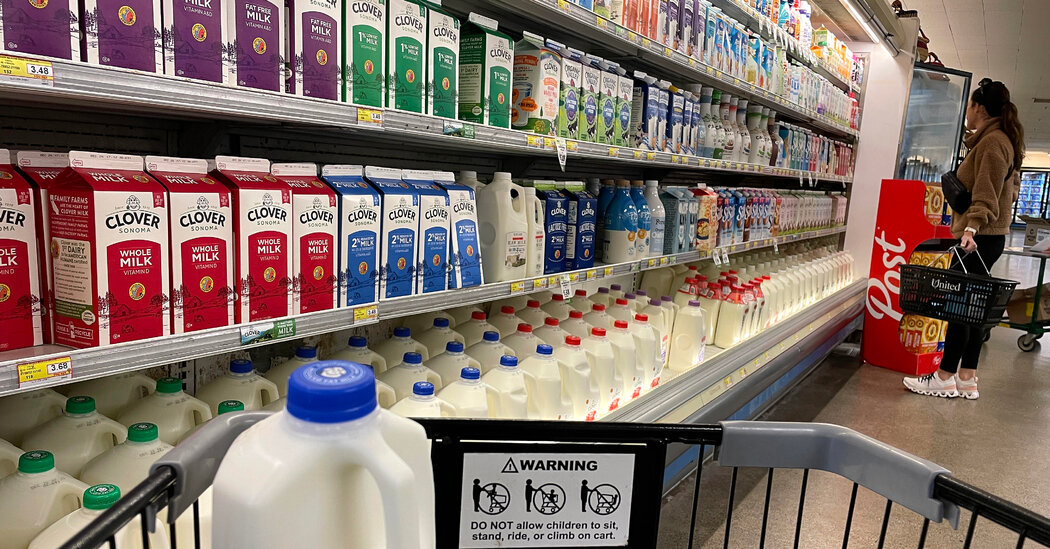
Federal regulators on Friday said that they had not yet discovered live bird flu virus in the first batch of retail milk samples they tested, a reassuring indication that the milk on store shelves remains safe despite an outbreak of the virus among diary cows.
In an online update, the Food and Drug Administration said an initial set of tests looking for live virus, not just genetic fragments, suggested that the pasteurization process was effectively neutralizing the pathogen.
“These results reaffirm our assessment that the commercial milk supply is safe,” the F.D.A. wrote in the update, adding that the testing efforts were ongoing.
Officials also tested infant and toddler formula, which incorporate powdered dairy, and did not find the virus, the agency wrote.
The F.D.A. embarked on a national survey of milk samples shortly after an outbreak of the bird flu virus, called H5N1, was discovered among dairy cows. Government scientists have been testing 297 samples of retail dairy products from 38 states, a swath of the country that covers regions far beyond the nine states known to have infected herds.
The first type of testing regulators conducted, a form of polymerase chain reaction, or PCR, is relatively speedy, but it picks up only genetic traces of the virus and does not tell researchers whether the live pathogen is present.
On Thursday, the F.D.A. said that those tests showed that roughly one in five retail milk samples nationwide contained fragments of bird flu virus, suggesting it was spreading among cows much more widely than previously known.
The samples containing genetic fragments are subsequently tested for live bird flu virus, which, if present, might represent a widespread health threat.
The test for live virus, called egg inoculation, is the most sensitive of its kind, but it takes time. The process involves injecting a portion of the milk product into chicken eggs, waiting for the virus to grow in the egg and then looking for signs of an infection.
Chicken eggs are efficient vessels for growing flu viruses; even scarce amounts will thrive there. For that reason, the F.D.A.’s new results strongly suggest that the tested samples did not contain infectious virus and that pasteurization is working, scientists said.
The negative results reported on Friday came from a “limited set of geographically targeted samples,” according to the F.D.A. Officials did not specify where the samples had come from.
“The answer at this point seems pretty conclusive that pasteurized milk is safe,” said Samuel Scarpino, a professor of the practice in health sciences at Northeastern University. “The fact that it’s coming back negative is really strong evidence that, at least in the samples they tested, there’s no live virus.”
Raw milk is never safe to drink, experts say, and it poses additional risks amid the bird flu outbreak in cattle. Almost all milk produced on U.S. farms is pasteurized, a process that kills pathogens with heat. Flu viruses are known to be fragile and sensitive to heat.
Scientists stressed that the federal government would need to test more milk samples and keep testing them as the outbreak continues. Some faulted officials for not acting sooner.
“The F.D.A. should have run these tests six weeks ago, when we first heard about it,” Dr. Scarpino said, referring to the outbreak among cattle.
Dr. Scarpino also urged the government to conduct egg inoculation experiments with milk containing varying concentrations of viral genetic material. Those tests, he said, could offer reassurance that even pasteurized milk containing copious amounts of genetic fragments remained safe to drink.
In addition to pasteurization, other existing safety procedures require that the milk of obviously symptomatic cows be kept from the commercial supply. While more studies are needed, Dr. Scarpino said, “you start to layer these things on top of each other, and it becomes vanishingly unlikely there’s actually going to be a problem.”
Andrew Bowman, a veterinary epidemiologist at Ohio State University who has been studying 150 retail milk samples he gathered around the Midwest, said that the F.D.A. findings mirrored the results from ongoing tests he was conducting for live virus.
The analysis from the F.D.A. on Friday showed that replicating virus was still unlikely to turn up in retail milk samples anywhere.
“I’ve got a gallon of milk in my fridge that might be used tonight,” he said.

